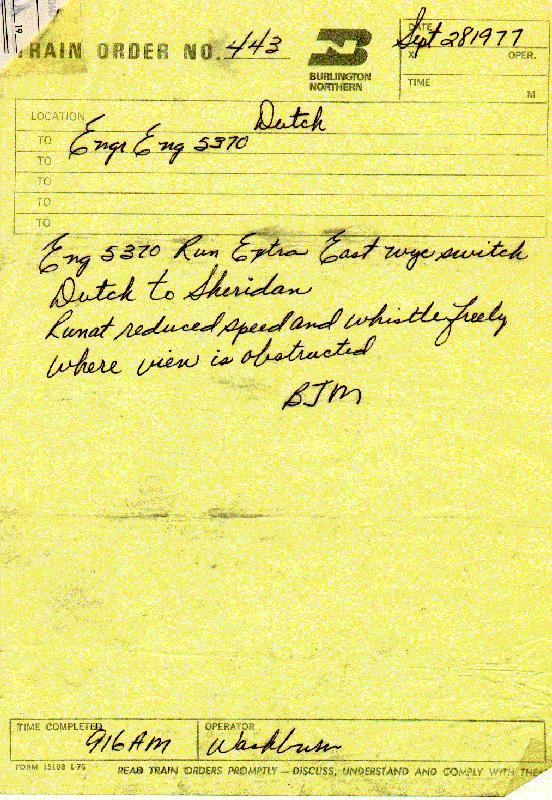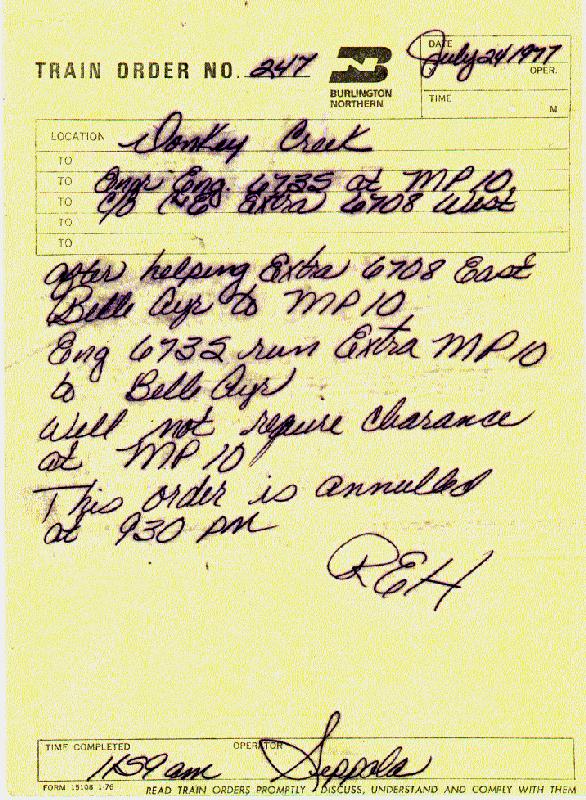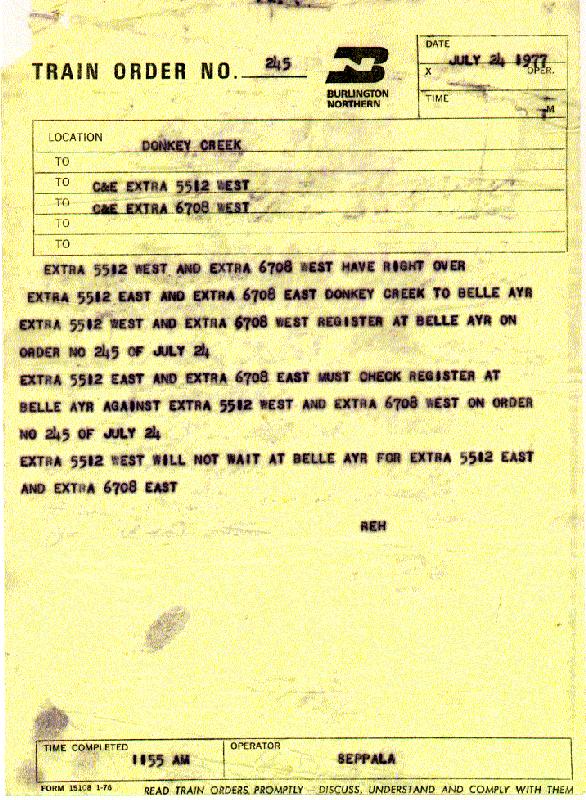
Train Orders. I have a million of them! I worked under Train Order operations in dark unsignalled territory for a decade or longer. I would like to do a lengthy essay on Train Order operations showing the many examples I have in my scrapbook but for now here is just a taste. Unless otherwise noted the Clearances and the Train Orders do not go together in this essay.It was a different world from todays TWC. For one thing TWC requires good radio communications between the train crew and the dispatcher at all places and times. In the 1970s we train crews were usually incommunicado with anybody for long portions of our trip. All running authority and meets had to be figured out ahead of time by the dispatcher. He then transmitted his orders to operators in depots along the line. The operators copied the dispatchers instructions, repeated them, then hooped the orders up to passing trains.
Imagine if you will, you are barreling along on a freight train at 49 mph, the legal limit in dark territory. You round the curve 1/2 mile from a lonely depot and see that the Train Order Signal is yellow. That means you must pick up train orders here.
OK, for you purists it actually means you must pick up a CLEARANCE here. It may or may not have train orders attached. If it does have train orders attached, which was the normal case, each train order number will be listed on the Clearance Form.
Call the caboose on the radio if both you and they have one. Tell the old man back there, "Yellow board at Clearmont". Whether he has a radio in the cabose or not he will be looking for that train order signal but warning him gives them a few more seconds to get down from the cupola and out on the back platform.
You slide your side windows open wide and lean out the window. The method of retrieval is the same whether the hoop is held by an operator standing next to the track or the hoop is mounted in a fixed train order stand. You stick your upper arm straight out and bend your forearm straight forward. Wave at the operator standing on the platform. Point your hand forward with your thumb tucked in tight. Aim your hand so it passes through the center of the triangle of string hooked to the hoop. Watch out for that lurch the loco always makes just at the last second. Instantly re-aim if the operator gal flinches backwards as the monster locomotive bears down on her at 50 mph. Believe me it takes guts to stand that close to the track as the loco grows to a size that blocks out all other objects. Your hand and forearm pass through the triangle of string and the inside of your elbow yanks the string free from the hoop. Crook your arm towards your chest and quickly bring your arm inside and close the window so the string, with the orders attached to it, can't blow back out the window. Don't forget to run the train all the while. Including blowing for the crossing that is always near the depots.
Remove the rolled up cylinder of clearance and train orders from the string. Getting one like this on the fly will keep you busy quite a while. Don't forget to run the train!

Read the Clearance Form and check that:Then check the orders themselves. See that each order:
- It is properly addressed to your train.
- It has the proper station.
- The date is proper.
- It has an "OK Time".
- It has the dispatcher's initials.
- It has the operator's name.
- It has the total number of orders listed.
- Count the order numbers to see that they agree with the number of orders stated.
Don't forget to run the train!
- Listed on the Clearance is actually there.
- Is properly addressed to your train.
- Has the proper station listed.
- Has a proper date.
- Has the dispatcher's initials.
- Has the "Complete Time".
- Has the operator's name.
- Read the order.

Train Orders can get complicated. If a train crew had to copy a train order via radio it got expensive. The agreements called for us to get what it would have cost the railroad to call out an extra operator, I.E., two hours overtime. Plus the railroad had to pay a penalty of the same amount to the nearest on duty operator. Needless to say the RR did not like paying these penalties and tried to avoid them whenever possible.The Belle Ayr helpers operated from the Belle Ayr Mine on the PRB Orin line to Whitetail. Whitetail was not even a siding at the time. It was just a station sign (no depot or anything) at the top of the hill at MP 10. So every time a helper shoved a coal train to Whitetail they had to copy an order via radio for running authority from there back to Belle Ayr. This was a real money maker on that job. You might shove 3 to 5 trains on your shift and get paid 2 hours penalty overtime for each one. You made more in radio train order penalties than you got for the day's pay! Ah those were the good ol' days. :-)
The same penalties applied to loaded trains leaving the Belle Ayr mine since there was no operator at Belle Ayr to give them orders. Some dispatchers tried to write train orders that avoided these expenses. The two Train Orders below are one example of this.

The order is addressed to the Engr Eng 6735 at MP 10. That is to the Engineer of Engine 6735 at milepost 10. It is further addressed to that engineer C/O C&E Extra 6708 West. Deciphered that is in the Care Of the Conductor and Engineer of Extra 6708 West. In other words, they are to deliver this train order to the helper engineer on the 6735.The 6708 West was a coal empty at Donkey Creek. Donkey Creek is the northern end of the PRB Orin line. At this time it was the ONLY connection. It is the junction of the Orin line with the CB&Q's "Long Branch" between Lincoln, Nebraska and Laurel, Montana.
The dispatcher has given the 6708 West a train order for it to deliver to the Belle Ayr helpers, 6735, at MP 10 (Whitetail). The train order gives the helper engines running authority from there back to Belle Ayr after shoving the loaded 6708 East from Belle Ayr to MP 10. Thus the dispatcher has "cheated" the helper crew, me, out of the two hours overtime penalty I would have gotten had I been required to copy this order myself via radio. Rats!
Think Ahead. Notice the order above was put out to the Extra 6708 West at Donkey Creek just before noon and it does not expire until 9:30pm. That is because the 6708 West must run from Donkey Creek to Belle Ayr, load its train, become the 6708 East and be shoved from Belle Ayr to MP 10, then I must run my light helper from MP 10 to Belle Ayr. The expiration time was necessary because there was no operator at Belle Ayr to report (O.S.) my light helper engines into Belle Ayr. That would leave a live train on the line forever and every train from then on would need meets set up with this non-existant train. When you dealt with train orders you had to think way ahead!
Tale of Two Trains Not shown are the running orders (running authority) for two trains. The 6708 would have recieved an order at Donkey Creek which stated something like:
Eng 6708 run extra Donkey Creek to Belle Ayr and return to Donkey Creek.
The 5512 would have recieved an order at Donkey Creek which stated something like:
Eng 5512 run extra Donkey Creek to Cordero and return to Donkey Creek. Extra 5512 East wait at Belle Ayr until 9:30pm.
Why does the returning 5512 have to wait at Belle Ayr until 9:30pm? Because until that time there is a live westbound out there, the helpers from order #247 above. All opposing moves must be protected. So why doesn't the 6708 East similarly have to wait at Belle Ayr until 9:30pm? Because my helper engine's running authority (6735) does not become active until after I shove the 6708 East. There is no conflict between the Extra 6708 East and my helper, the Extra 6735 West, because the Extra 6735 West does not exist until after the Extra 6708 East has passed MP 10.
It's a Doozy. This next order is for the same train, 6708, that delivered the helper its orders above. It was also delivered to it at Donkey Creek. It is the convoluted result of issuing advance running orders for the returning loaded trains in order not to pay penalties to coal train crews at the mines. It protects the returning eastbound moves against each other's westbound moves. Instead of issuing separate right over orders and separate register check orders to each train against the other the dispatcher has elected to combine everything into one order.

The above order is addressed to two westbound trains, the Extra 5512 West and the Extra 6708 West. The first two lines are:
Extra 5512 West and Extra 6708 West have right over
Extra 5512 East and Extra 6708 East Donkey Creek to Belle Ayr.
This gives the two westbounds right over the two eastbounds which means the eastbounds cannot leave Belle Ayr until the westbounds have arrived there. Those of you who are paying attention may have noticed that the two westbounds and the two eastbounds are the same trains! This is because the westbounds will run to the mine, load, and return as eastbounds. Because the dispatcher has elected to combine several separate orders onto one order it results in both trains checking on their own return move in addition to the other train.The next two lines tell the westbounds to register at Belle Ayr.
Extra 5512 West and Extra 6708 West register at Belle Ayr on
order number 245 of July 24.
A register is an official book that is kept at a specified location. When instructed to do so, trains must register their arrival by writing in the book. They will write that they have arrived at Belle Ayr giving their train ID, time & date of arrival, and the order number upon which they are registering this arrival. (The same engines could arrive at a station more than once per day. Helpers do it all the time. So just checking for an engine number is not good enough. You must check the order number too.) Registering is a method that provides a means other crews can check to see what trains have arrived or departed even though they themselves may not have actually seen those trains.The next two lines permit the eastbounds to check the register to see if these trains have indeed arrived.
Extra 5512 East and Extra 6708 East must check register at Belle Ayr against Extra 5512 West and Extra 6708 West on order number 245 of July 24.
When the eastbounds are ready to leave Belle Ayr they have to be certain that the two westbounds have arrived there because the two westbounds have right over them. To be certain both westbounds have arrived the eastbounds are to check the register.The last two lines confused me.
Extra 5512 West will not wait at Belle Ayr for Extra 5512 East
and Extra 6708 East.
As I write this today I wondered what is the sense of that order? It has been a long time since I worked under train orders so my brain is a bit rusty. I could not figure this one out for a while. Then it struck me. This is another result of the dispatcher combining everything into one order. That resulted in the 5512 West having right over itself as an eastbound. Since the Extra 5512 West only has right over the two eastbounds to Belle Ayr it could not go further west until the two eastbounds arrived at Belle Ayr. This is not a problem for the Extra 6708 West since it is only going to Belle Ayr anyway but the 5512 has running authority to proceed west of Belle Ayr to Cordero. The last two lines relieve it from waiting on the 6708 East and itself. It is possible for the dispatcher to give this authority since the 6708 East has no running authority beyond Belle Ayr and the 5512 cannot run into itself.
Had enough? I find train orders interesting. Much more so than Track Warrants. Train Orders can be quite a puzzle at times. Perhaps you find them boring? Well, to each his own. Some day I might actually get that essay written about my collection.



| Return to Tales index | My Home Page | E-Mail me |